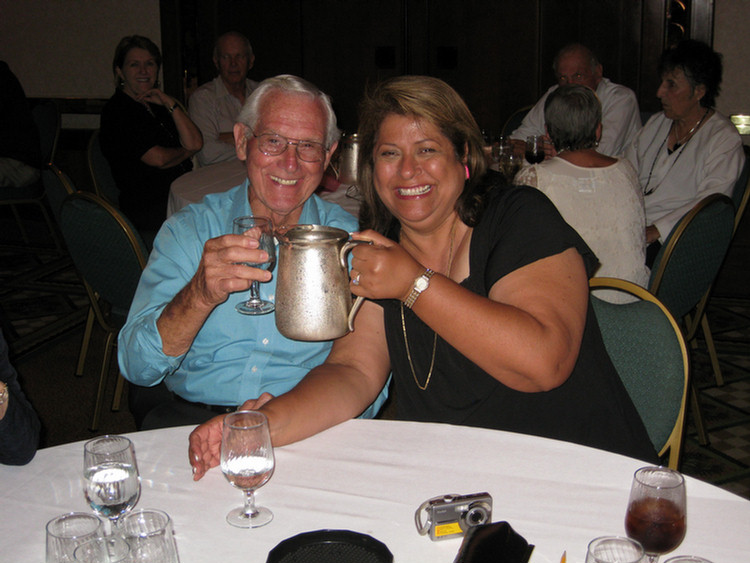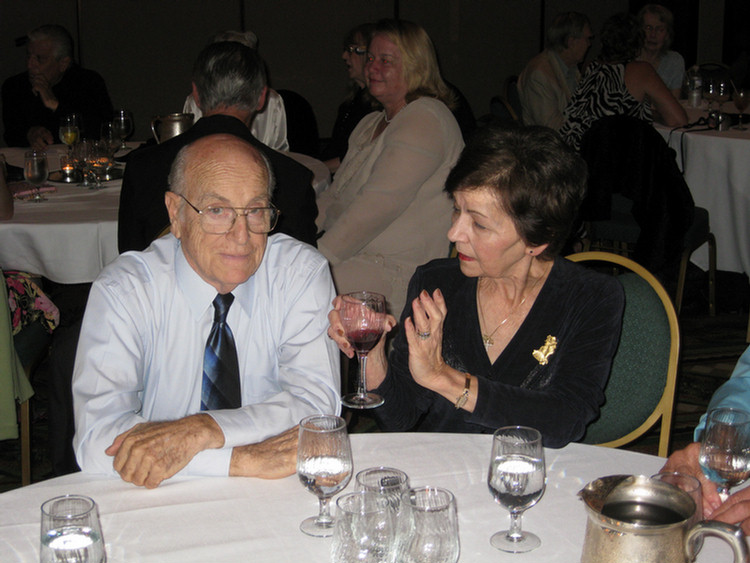September 13, 2009
Tracy Wells – A Long Beach resident,Tracy is a transplanted Midwesterner from Quincy, Illinois. In earlier years he led big bands at the U.S. Naval Academy and at the University of Missouri. Later in Southern California he was featured with the Johnny Ricardo Latin band, free-lanced with jazz groups, vocal groups, and led other bands. Tracy is a trumpeter, vibraphonist, vocalist and arranger.

Paul and Sue holding the second table

Poof! It is held!

Jim and Jan Mongel

Great music

Del is showing Jan a new step, no... really!

Jim and Jan Mongel dancing

Nancy and Vince are tearing up the floor

Paul & Sue

Young people are also dancing




Del is looking for his moth!

"What is she saying to me???"


"This is a xylophone"
Did you know? - The xylophone (from the Greek words ξύλον - xylon, "wood" + φωνή - phone, "voice", meaning "wooden sound") is a musical instrument in the percussion family which probably originated in Slovakia. It consists of wooden bars of various lengths that are struck by plastic, wooden, or rubber mallets. Each bar is tuned to a specific pitch of the musical scale. The term "xylophone" can refer to Western-style concert xylophones or to one of the many wooden mallet percussion instruments found around the world. Xylophones are tuned to different scale systems depending on their origin, including pentatonic, heptatonic, diatonic, or chromatic. The arrangement of the bars is generally from low (longer bars) to high (shorter bars).
The xylophone is a historical instrument that originated independently in Africa and Asia. An older hypothesis that has seen acceptance among some specialists is that the instrument was invented in Indonesia and spread subsequently to Africa. Many however, see this theory as "rash" and even "preposterous", based on the limited amount of evidence to suggest this to be true. Wooden bars were originally seated on a series of hollow gourds, and the gourds generated the resonating notes that are produced on modern instruments by metal tubes. For centuries, xylophone makers struggled with methods of tuning the wooden bars. Old methods consisted of arranging the bars on tied bundles of straw, and, as still practiced today, placing the bars adjacent to each other in a ladder-like layout. Ancient mallets were made of willow wood with spoon-like bowls on the beaten ends.
The earliest evidence of a xylophone is from the 9th Century in southeast Asia according to the Vienna Symphonic Library, and there is a model of a similar hanging wood instrument, dated to ca. 2000 BC in China.
Java and Bali use xylophones (called gambang) in gamelan ensembles. Still have traditional significance in Africa, Malaysia, Melanasia, Center Valley, Indonesia, and regions of the Americas. A type of xylophone used in India was the kashta tharang.
It is likely that the xylophone reached Europe during the Crusades. The latest historical reference in Europe is in 16th-century Germany in the organist Arnold Schlick's Spiegel der Orgelmacher und Organisten. [3] By the 19th century the xylophone was associated largely with the folk music of Eastern Europe, notably Poland and eastern Germany. By 1830, the xylophone had been popularized to some extent by a Russian virtuoso named Michael Josef Gusikov,[4] who through extensive tours made the instrument known. His instrument was the five-row “continental style” xylophone, made of 28 crude wooden bars, arranged in semitones in the form of a trapezoid, and resting on straw supports. It was sometimes called the “strohfiedel” or “straw fiddle”. There were no resonators and it was played with spoon-shaped sticks. According to the musicologist Curt Sachs, Gusikov performed in garden concerts, variety shows, and as a novelty at symphony concerts. (Certainly in the 1830’s a xylophone solo was a novelty.) Noted musicians, including Felix Mendelssohn, Frederic Chopin, and Franz Liszt spoke very highly of Gusikov’s performances. Perhaps due to his great influence, xylophonists continued to be featured in theater shows and concert halls until well into the 20th century.

Tracy and Paul used to work together at North American Aviation in the 1960's

Nancy and Vince Adamson

Barney and Margo Adams








The dancing continues






Good night; See you Thursday at the Phoenix Club